Have you ever dreamed of growing your own cut flowers? Well, now you can with these simple-to-grow cutting garden plants!
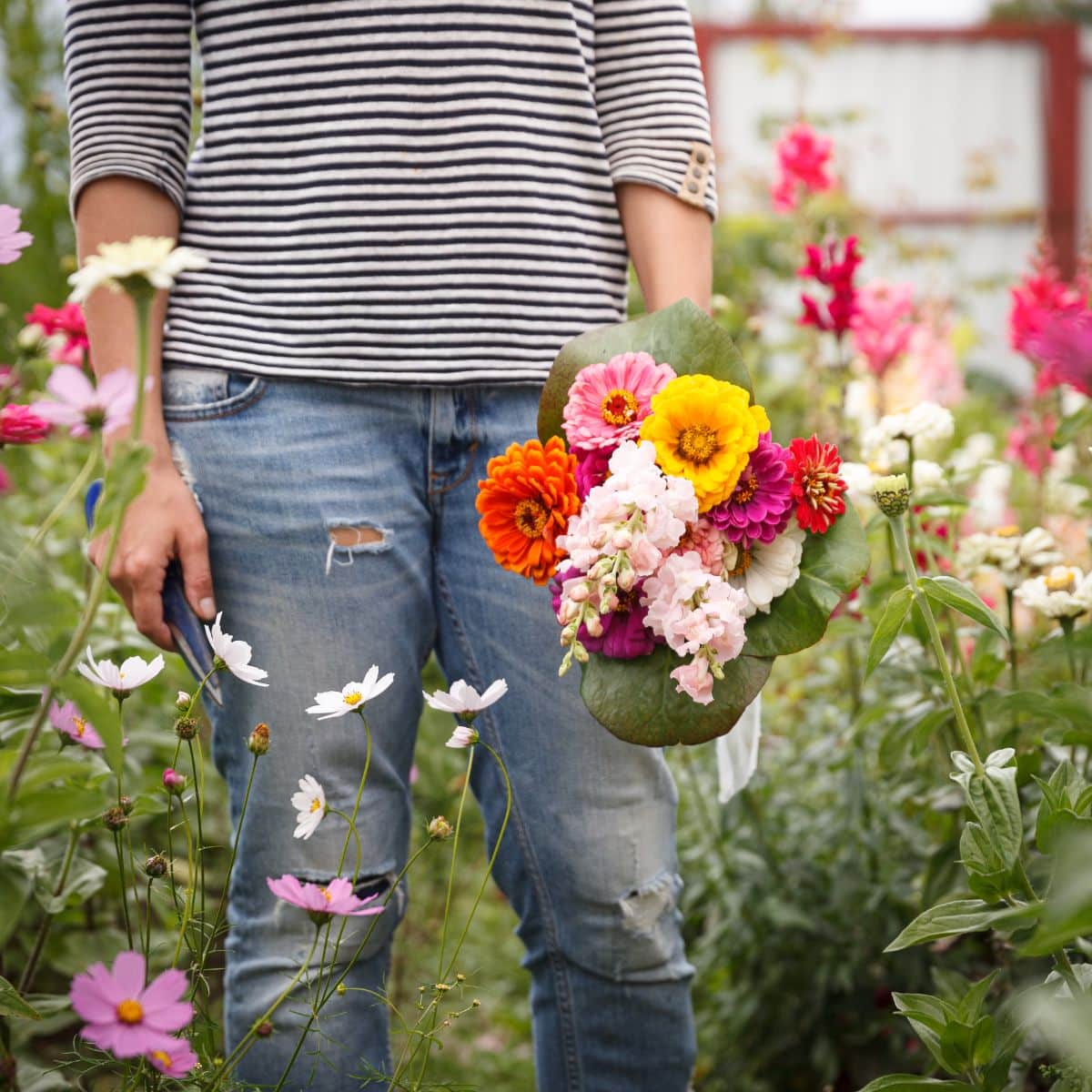
Imagine stepping out into your garden this summer and gathering up armloads of fresh zinnias, sunflowers, and cosmos to craft your own homemade bouquets. Or perhaps the idea of creating your own flower arrangements to sell at craft fairs and farmer's markets is more appealing to you. Either way, if the thought of growing your own cutting garden excites you, there are lots of gorgeous cut flowers that you can grow right in your backyard!
In this guide, you’ll discover some of the easiest cut flowers to grow for bouquets, floral arrangements, and other crafting. From classic roses to scented favorites like peonies, we’ve got the best plants for a cutting garden right here!
Jump to:
- 18 best flowers to grow in a cutting garden
- 1. Roses (Rosa spp.)
- 2. Cosmos (Cosmos spp.)
- 3. Dahlias (Dahlia spp.)
- 4. Sunflowers (Helianthus spp.)
- 5. Yarrow (Achillea millefolium)
- 6. Celosia (Celosia spp.)
- 7. Sweet peas (Lathyrus odoratus)
- 8. Gladiolus (Gladiolus spp.)
- 9. Black-eyed Susan (Rudbeckia hirta)
- 10. Tulips (Tulipa spp.)
- 11. Asters (Aster spp.)
- 12. Irises (Iris spp.)
- 13. Peonies (Paeonia spp.)
- 14. Ageratum (Ageratum houstonianum)
- 15. Zinnias (Zinnias spp.)
- 16. Daffodils (Narcissus spp.)
- 17. Alliums (Allium spp.)
- 18. Ranunculus (Ranunculus spp.)
- Summary
18 best flowers to grow in a cutting garden
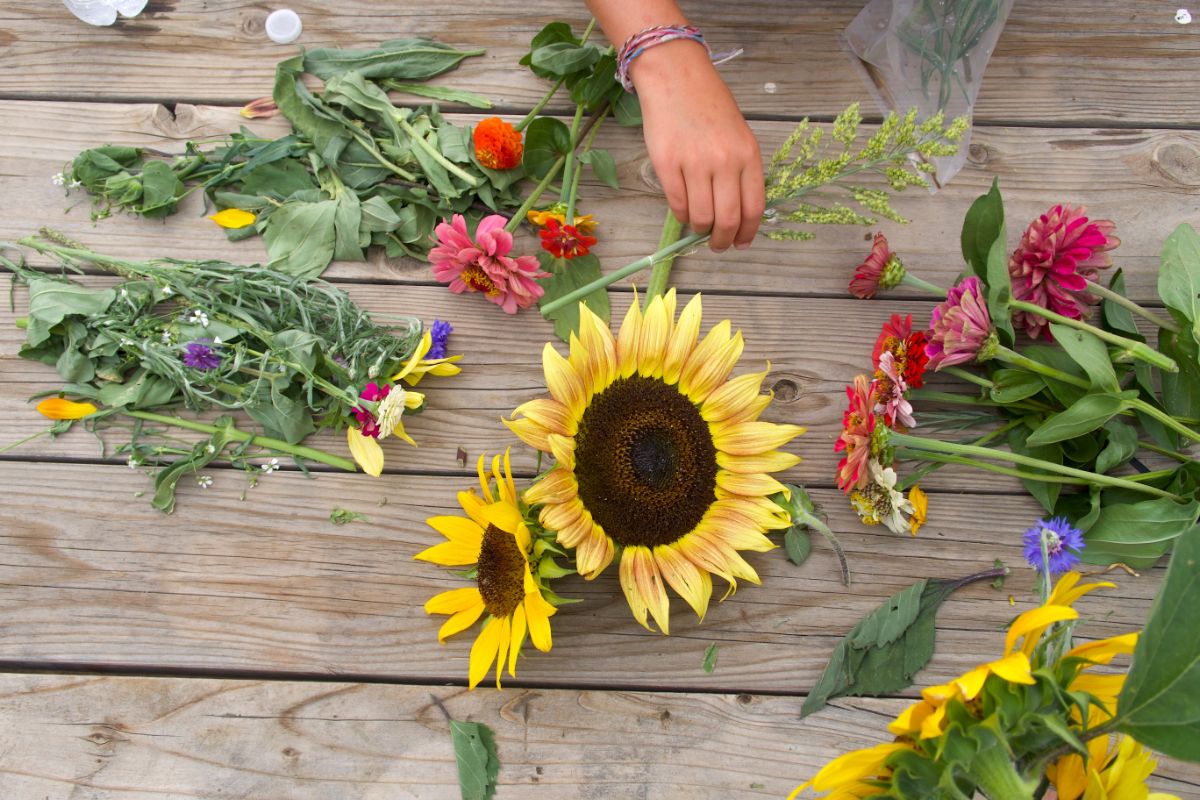
While you can fit more cut flowers in a large cutting garden, there are plenty of attractive flowers that you can keep in a small space window box or container garden. In the list below, you’ll find flowers of all different shapes, sizes, flower colors, and bloom times to suit any flower gardener or market gardener’s needs.
1. Roses (Rosa spp.)
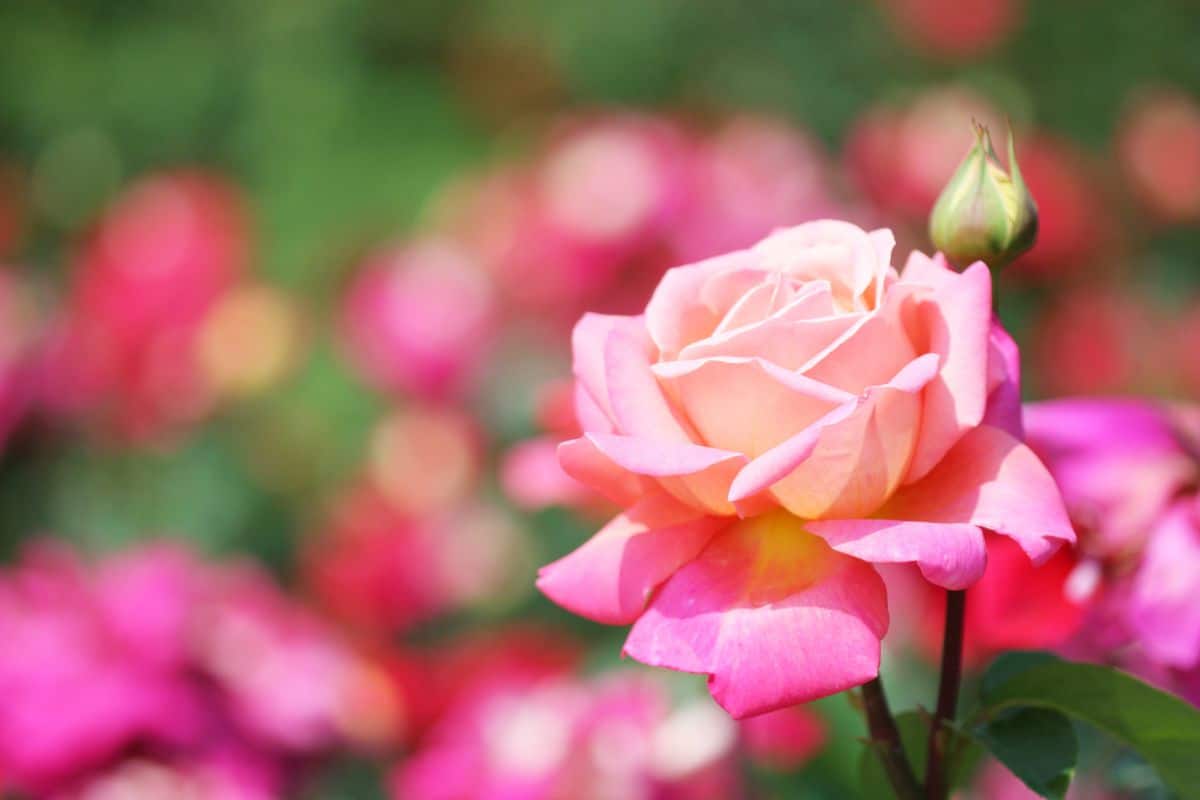
| Plant name: | Roses |
| Light requirements: | Full sun |
| Water requirements: | Moderate |
| Grow zone: | Zones 3 to 11, depending on variety |
| Toxic to pets: | No |
Every year, over 250 million roses are grown commercially for Valentine’s Day, and roses are also one of the top flowers exchanged at other holidays as well. But roses can be easily grown in most home gardens, and if you grow your own, you’ll have more choices of flower colors, bloom sizes, and fragrance intensity to choose from.
One of the reasons why roses are such commonly kept flowers is that they are quite cold-hardy, and some roses can even be grown in areas as chilly as Zone 3! Today, there are lots of rose cultivars to choose from, including some plants that are incredibly disease-resistant and other plants that stay small and are perfect for container growing. If you like roses with lots of fragrance, look for heirlooms or antique rose types, like Damask roses, China roses, and Alba roses.
2. Cosmos (Cosmos spp.)
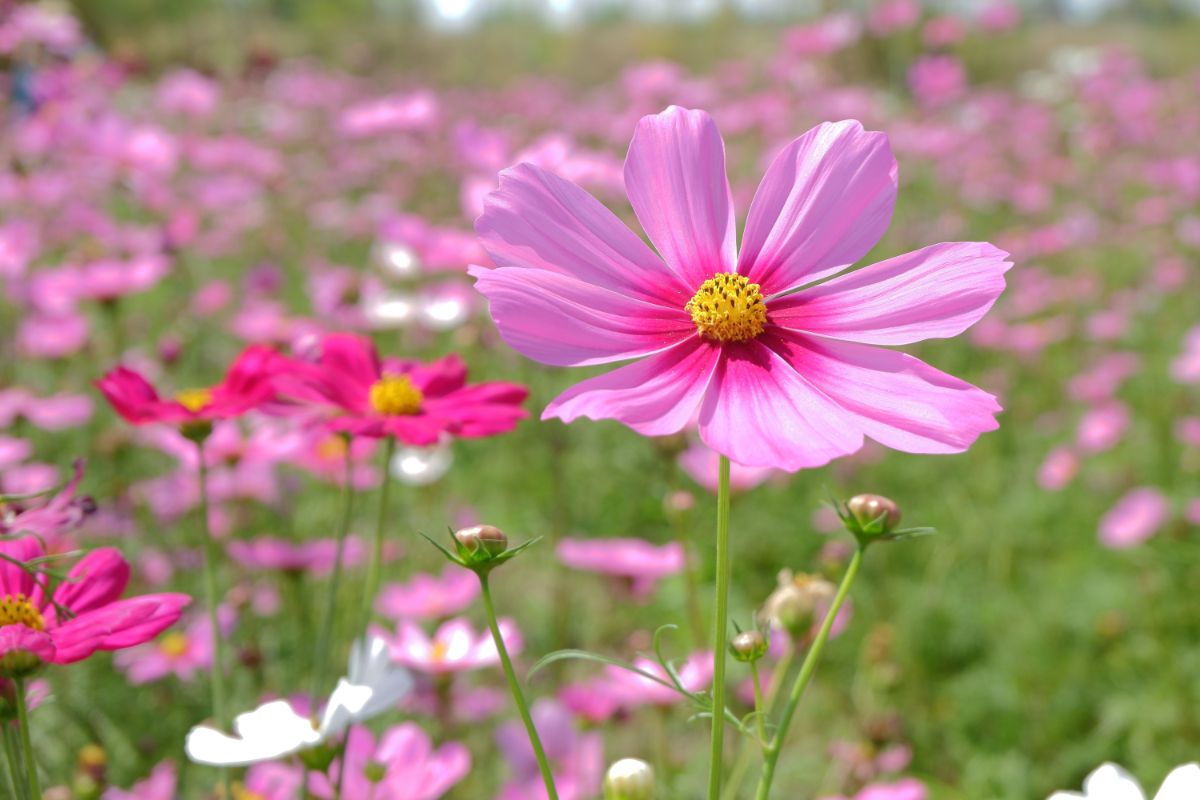
| Plant name: | Cosmos |
| Light requirements: | Full sun |
| Water requirements: | Moderate to low |
| Grow zone: | Zones 2 to 11 |
| Toxic to pets: | No |
Cosmos are happy-looking plants with bright pink and white flowers that have wide open faces. Cosmos also features fine, feathery foliage that adds a nice, airy quality to cut flower arrangements. And, while cosmos will work well in bouquets by themselves, they pair beautifully with many other cut flowers, such as coneflowers and yarrow, to create a showstopping bouquet.
Most cosmos are annual flowers, which means they will need to be replanted every year if you’d like to keep your flowers coming back. The good news is that cosmos self-sow quite readily, and if you don’t deadhead spent blooms, there’s a good chance they will seed themselves. Even better, cosmos are also quite hardy plants, and they are even drought-tolerant once established!
3. Dahlias (Dahlia spp.)
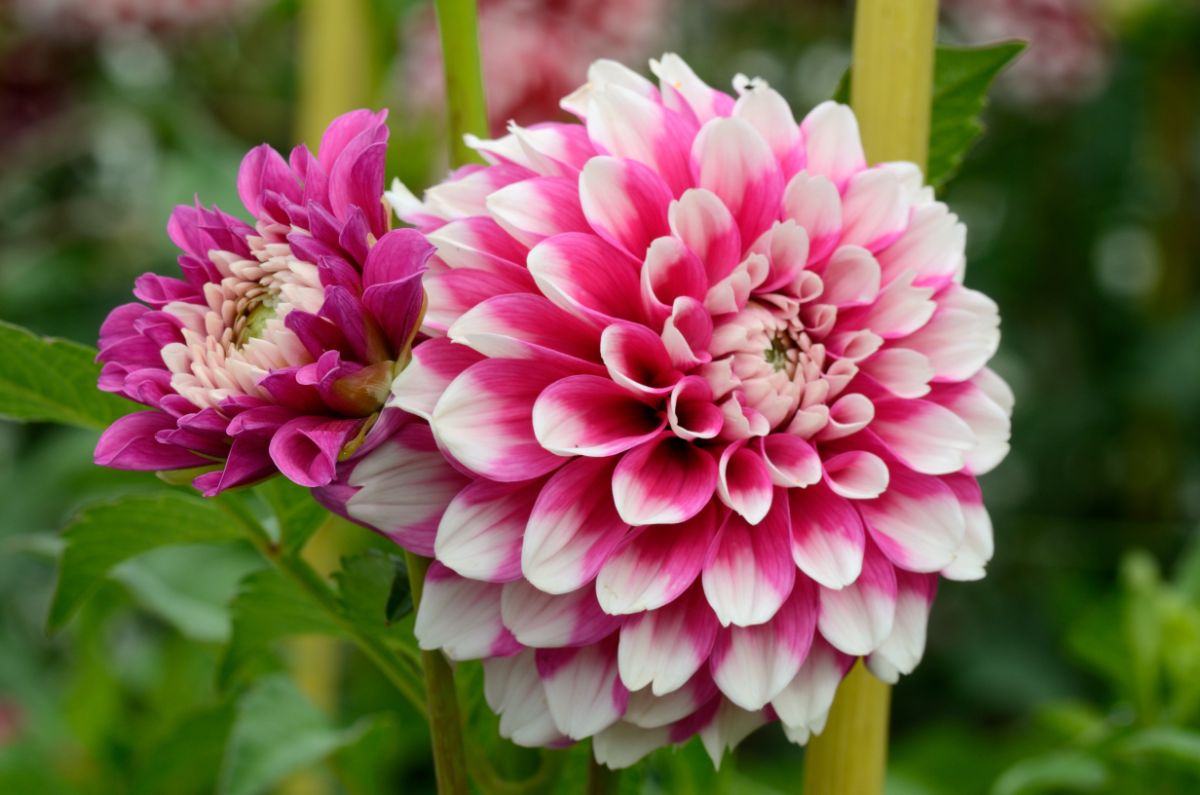
| Plant name: | Dahlias |
| Light requirements: | Full sun |
| Water requirements: | Moderate |
| Grow zone: | Zones 8 to 10, tubers can be overwintered indoors in cooler climates |
| Toxic to pets: | Yes |
One of the showiest cut flowers you can find, dahlias come in all shapes, sizes, and colors, and they make spectacular bouquets. Some dahlias have single-bloom flowers, but other dahlias, like pompom dahlias, have very fancy double blooms that make perfect central flowers in arrangements. Dahlias also have nice, sturdy stems that perfectly support the flower heads in vases.
One of the tricky things about dahlias is that they love the heat! But in cooler climates, dahlia tubers will need to be dug up in autumn and overwintered indoors. Beyond that, dahlia care is pretty simple, but flowers may need to be staked when they’re in bloom since their flower heads can get so heavy they can weigh down their stems!
4. Sunflowers (Helianthus spp.)
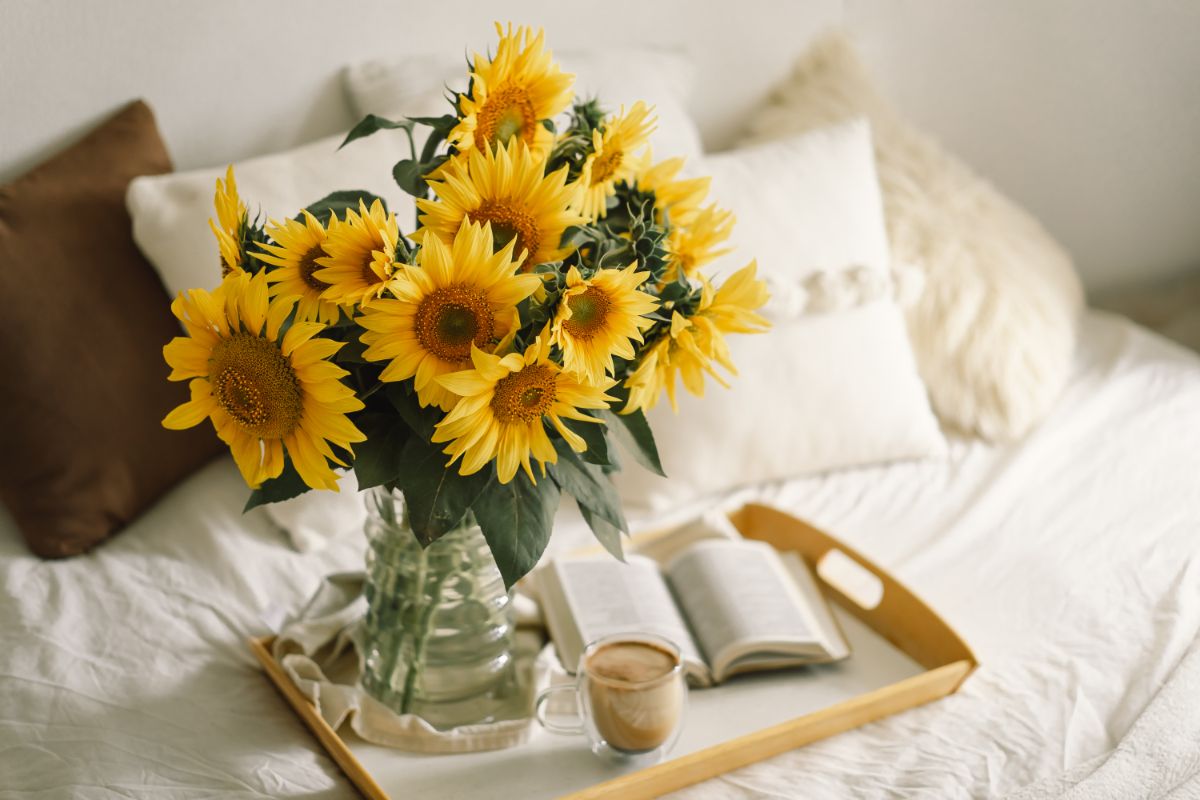
| Plant name: | Sunflowers |
| Light requirements: | Full sun |
| Water requirements: | Moderate |
| Grow zone: | Zones 4 to 9 |
| Toxic to pets: | No |
The stars of summertime gardens, sunflowers are some of the cheeriest plants you can grow, and they are also top choices for bouquet making. While sunflowers can be grown for their edible seeds, many sunflower varieties have wildly colored flowers that are excellent for flower arrangements. Golden-yellow flowers are the most common, but some cultivars have dark maroon or even pearly white petals!
Most sunflowers grow large, and you’ll need a big garden to keep them happy; however, you can also find dwarf sunflower varieties that are just the right size for container growing. Sunflowers are annual plants, which means they don’t overwinter, but they sprout easily from seed, and they grow quickly enough that they’ll reach full maturity and flower before winter in most growing regions. If you don’t use sunflowers for bouquets, these plants also produce large seed heads that wild birds love feasting on!
5. Yarrow (Achillea millefolium)
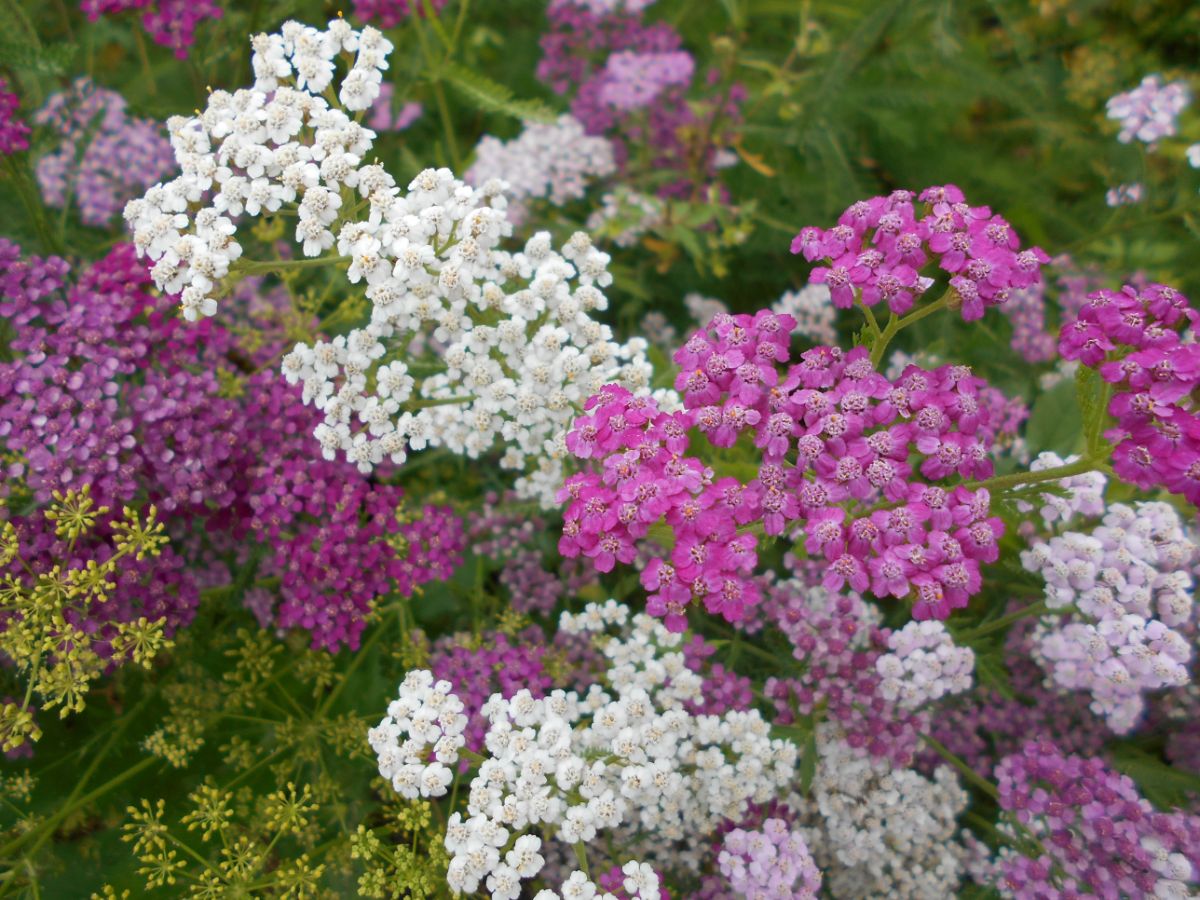
| Plant name: | Yarrow |
| Light requirements: | Full sun |
| Water requirements: | Low |
| Grow zone: | Zones 3 to 9 |
| Toxic to pets: | Yes |
If you’re new to keeping flowers, yarrow is one of the best-cut flowers to grow since it is a very forgiving plant that can grow in a range of conditions. Yarrow is well-known for its broad, flat flower heads, which come in pink, yellow, and white. Those flowers are complemented by the plant’s feathery foliage, which adds a dainty yet alluring texture to flower arrangements.
Yarrow can grow in a range of soil types, and they are also very drought-tolerant plants that won’t need a lot of extra fuss in the garden. In mixed beds, yarrow looks stunning when grown beside other drought-tolerant flowers, like coneflowers and cosmos. And if you want to attract butterflies to your garden, planting yarrow is one of the best ways to do just that!
6. Celosia (Celosia spp.)
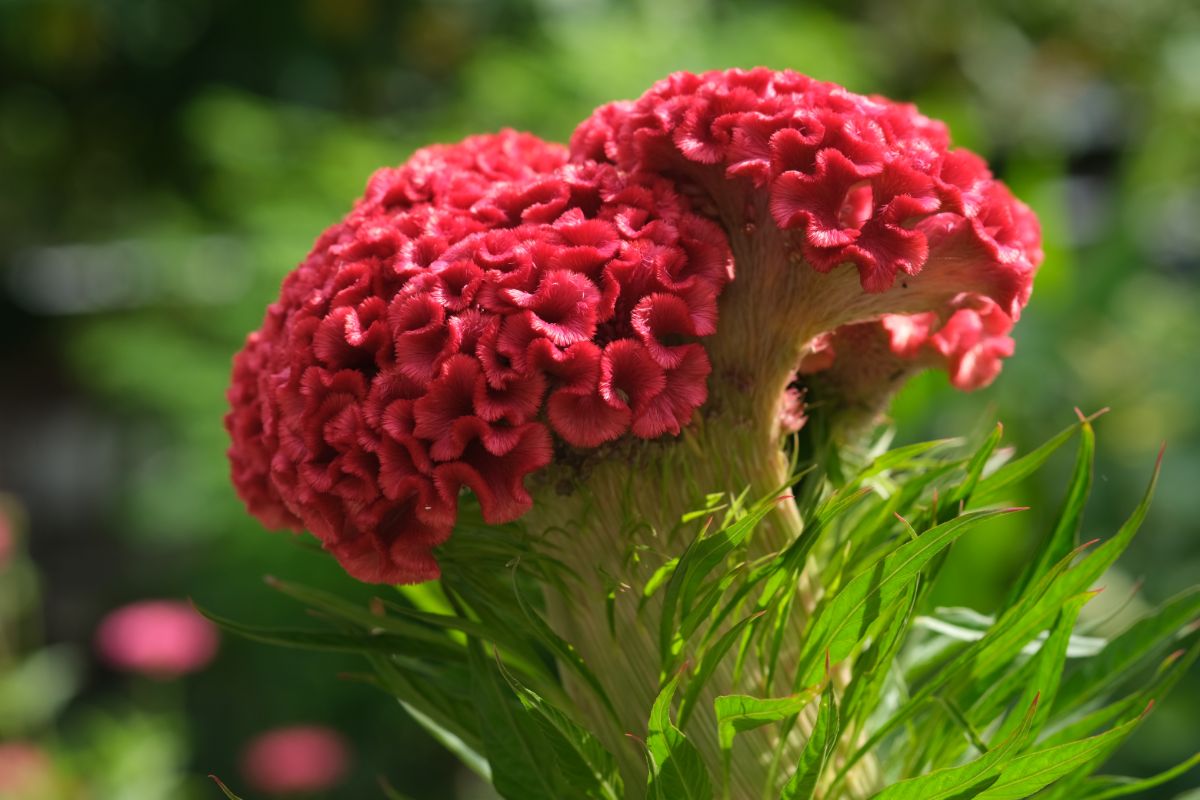
| Plant name: | Celosia |
| Light requirements: | Full sun |
| Water requirements: | Moderate |
| Grow zone: | Zones 10 to 11, grown as annuals in most locations |
| Toxic to pets: | No |
Another flashy annual plant, celosia, is a top-cut flower to grow if you love working with bold, bright colors. Celosia flowers come in a range of shapes, including the spiky-looking tufted celosia and the curious, crested cockscomb celosia, which looks a bit like something that came from the sea! Celosia flowers are warmly colored, with blooms in highly saturated tones of bright pink, orange, red, and yellow.
Celosia plants grow between 1 and 3’ tall, and they can make an impact in inground beds or container gardens. These plants also love the heat, and they grow well in garden beds that are too sunny for other flowers to tolerate. While celosia makes a brilliant cut flower, blooms also dry beautifully for preserved displays.
7. Sweet peas (Lathyrus odoratus)
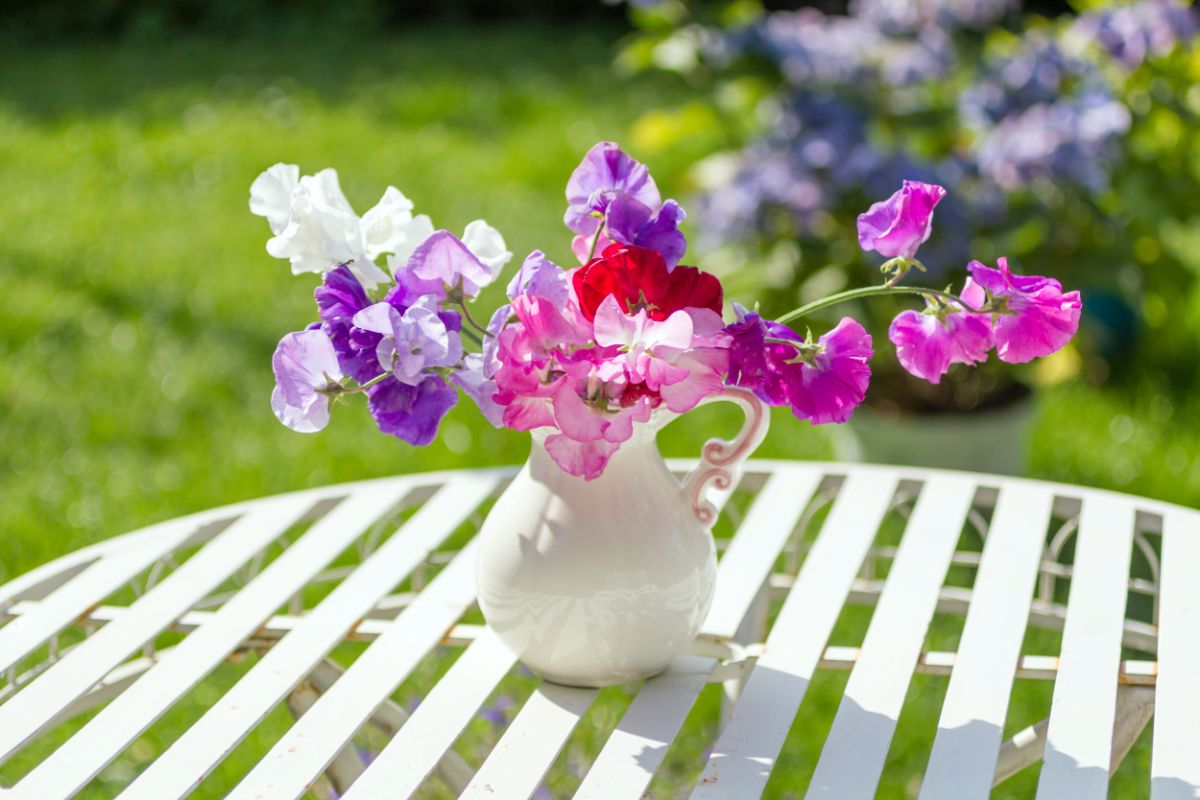
| Plant name: | Sweet peas |
| Light requirements: | Full sun; may benefit from part afternoon shade in hot areas |
| Water requirements: | High |
| Grow zone: | Zones 2 to 11 |
| Toxic to pets: | Yes |
A favorite of spring and autumn gardens, sweet peas are delicate-looking plants, but they can pack a punch in cut flower gardens. While sweet peas can be grown in window boxes and containers, they show best when they’re allowed to climb up trellising or twine their way around porch railings. Sweet pea flowers have sweet, rounded petals that come in various shades of pink, red, blue, purple, and white.
Sweet peas don’t handle the heat well, but they are quite cold-tolerant, which allows them to be planted in early spring. While plants will die back during the summer heat, you can plant a second crop of sweet peas in mid-summer and pick a second harvest of flowers in the fall if you want to. Despite their name, sweet peas are not related to edible peas, and they are toxic if ingested.
8. Gladiolus (Gladiolus spp.)
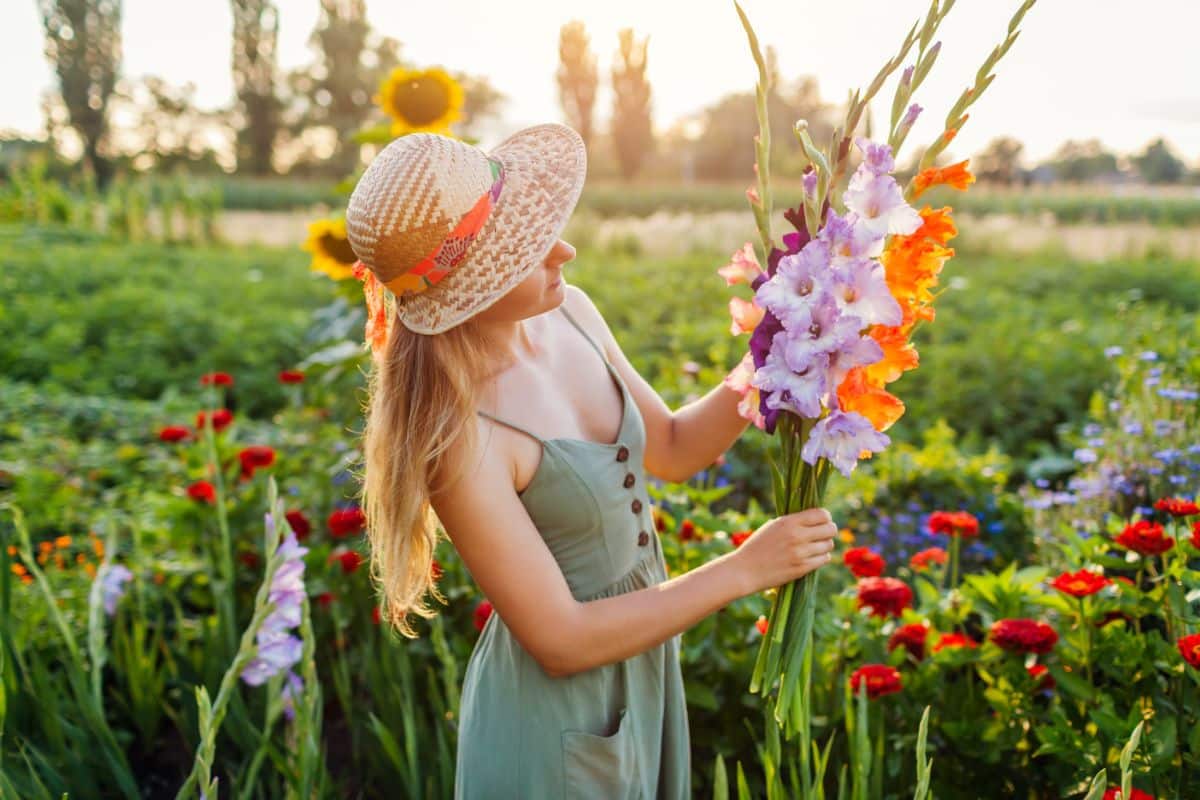
| Plant name: | Gladiolus |
| Light requirements: | Full sun |
| Water requirements: | High to moderate |
| Grow zone: | Zones 8 to 10, corms can be overwintered indoors in cooler climates |
| Toxic to pets: | Yes |
Gladiolus are some of the most dramatic-looking flowers you can grow, and they lend a tropical feel to bouquets. But, despite their glamorous look, gladiolus are surprisingly easy plants to grow, and they don’t take up a lot of space in garden beds, especially if they’re grown in rows. Gladiolus flowers come in a veritable rainbow of colors, too, including pink, purple, and even green!
Like dahlias, gladiolus are not cold hardy plants, and they can only be grown as annuals in zones 7 and below. However, you can also overwinter gladiolus corms indoors or can keep your plants in pots and bring them inside in the winter if you live in a cooler climate. When it comes to picking gladiolus flowers, the best time to harvest them is when only one or two of the lower buds has begun to open, and the remaining flowers will unfurl indoors.
9. Black-eyed Susan (Rudbeckia hirta)
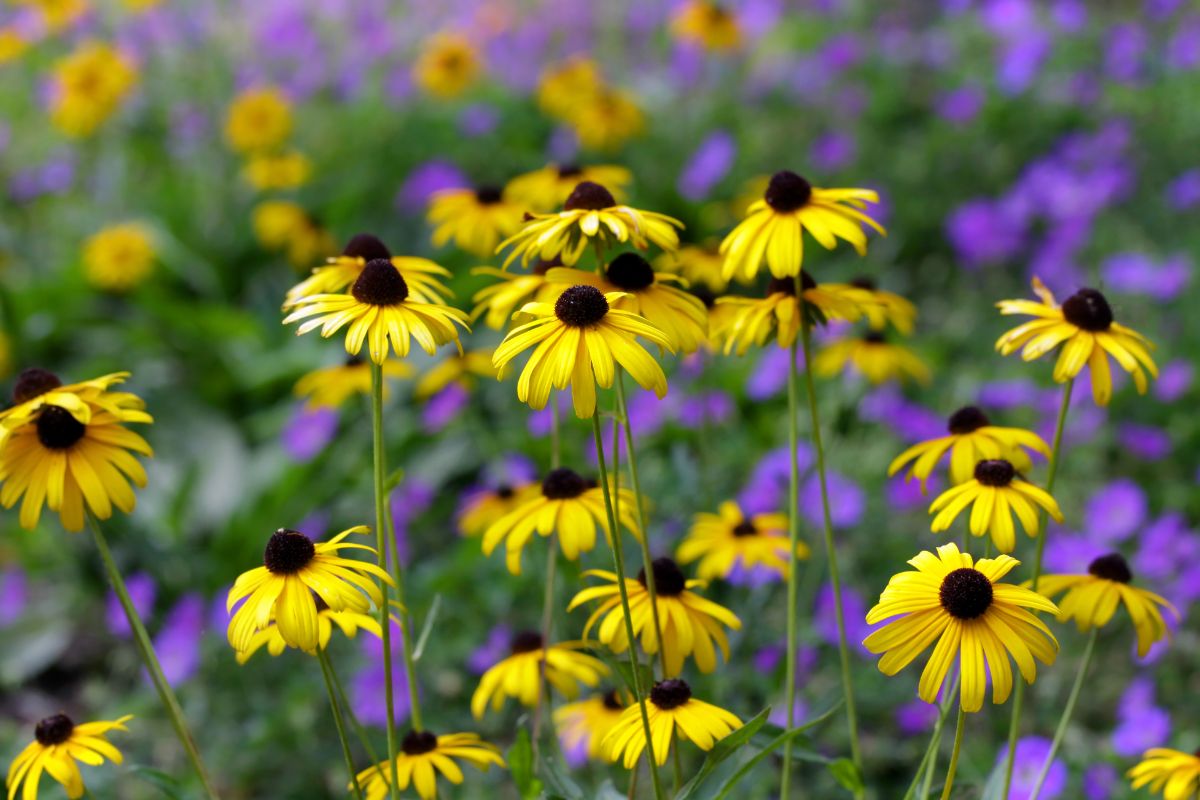
| Plant name: | Black-eyed Susan |
| Light requirements: | Full sun to part shade |
| Water requirements: | Moderate to low |
| Grow zone: | Zones 3 to 10 |
| Toxic to pets: | Yes |
Hardy black-eyed Susan can grow just about anywhere, making them one of the best-cut flowers for beginning gardeners. Drought-tolerant and heat-resistant, black-eyed Susan can grow in sunny, exposed areas, but they can also tolerate some afternoon shade. Additionally, black-eyed Susan readily self-sows, and it will spread throughout your garden unless you deadhead spent blooms.
As cut flowers, black-eyed Susans are long-lasting and colorful, even if they aren’t the showiest flowers. In rustic bouquets, black-eyed Susan makes a fine complement to sunflowers, coneflowers, and yarrow, but these versatile plants can also be used with bigger blooms, like dahlias. Additionally, if you leave some of these flowers in your garden, they produce large seed heads that provide a valuable food source for birds at the end of the growing season.
10. Tulips (Tulipa spp.)
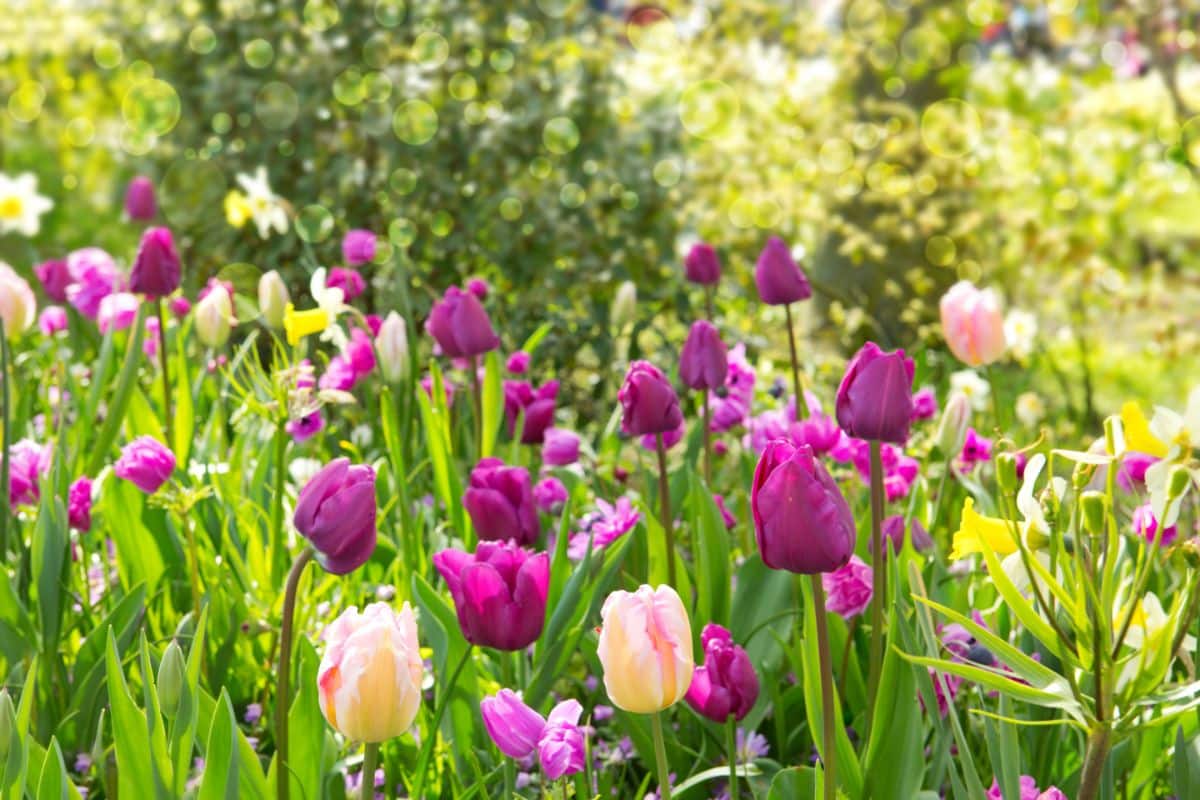
| Plant name: | Tulips |
| Light requirements: | Full sun |
| Water requirements: | Low |
| Grow zone: | Zones 3 to 7 |
| Toxic to pets: | Yes |
A staple in spring gardens, tulips are another classic plant to grow in cutting gardens. Prized for their boldly colored flowers, you can find tulips in just about any color you could want. You can also find tulip varieties with frilly or double flowers that look a lot like peonies and are absolutely stunning in springtime bouquets.
Like many other bulbs, tulips need to be planted in autumn to produce spring blooms. Additionally, because these plants are not super cold hardy, it’s important to plant them at the right planting depth to ensure they come back year after year. Tulips should be planted about 6 to 8” deep, and adding a bit of compost to your planting holes can encourage your plants to settle into your garden more quickly.
11. Asters (Aster spp.)
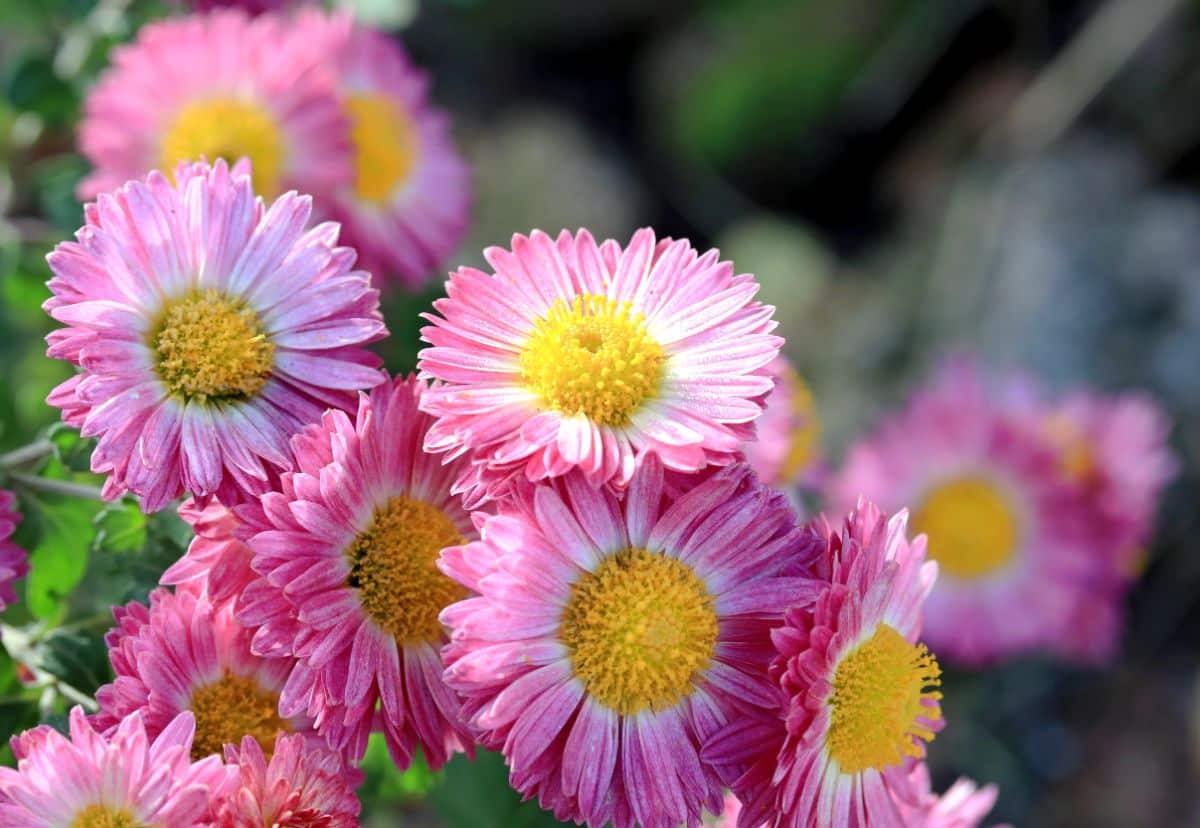
| Plant name: | Asters |
| Light requirements: | Full sun to part shade |
| Water requirements: | Moderate |
| Grow zone: | Zones 3 to 8 |
| Toxic to pets: | No |
A common sight in autumn gardens, asters are known for their pretty, daisy-like flowers, which come in a range of bright colors. There are about 170 different species of asters, and some grow as wildflowers, so you may not need to sow these plants at all. But if you want to grow asters from seed, varieties like ‘Matsumoto Apricot’ and ‘Hazaster Hagan’ are spectacular additions to cut flower arrangements, and they are so showy they may even outshine big bloomers like dahlias!
Because they bloom so late in the year, asters are an important pollinator plant, and they provide one of the last meals of pollen and nectar for bees at the end of the season. These plants are also quite easygoing and are generally drought-tolerant once established in garden beds. You can find asters in a wide range of sizes, too, from pint-sized beauties that are perfect for container gardens to larger, 6’ tall asters that make excellent backdrop plants in mixed beds.
12. Irises (Iris spp.)
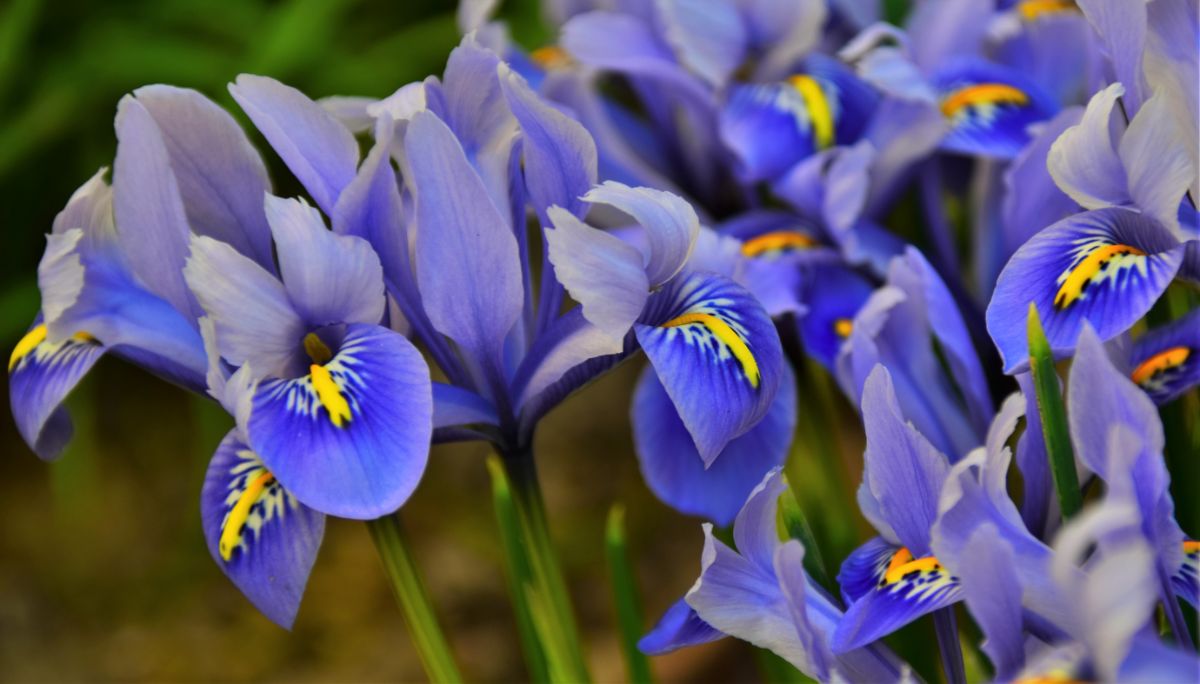
| Plant name: | Irises |
| Light requirements: | Full sun to part shade |
| Water requirements: | Moderate |
| Grow zone: | Zones 3 to 9, depending on variety |
| Toxic to pets: | Yes |
Most irises bloom in either spring or summer; however, you can find reblooming iris varieties that will bloom in fall as well. Depending on your garden size, you can select dwarf iris varieties or full-sized irises that grow up to 4’ tall. Iris flowers come in many different colors, too, and some varieties have ruffled petals for even more texture and interest.
Irises tend to like lots of water, so if you have a poorly draining section of your garden, you may want to keep irises there. Some irises can also grow along ponds and streams, making them a suitable choice for rain gardens or other water features. As cut flowers, irises are definitely “thriller plants” that will add lots of color to any bouquet!
13. Peonies (Paeonia spp.)
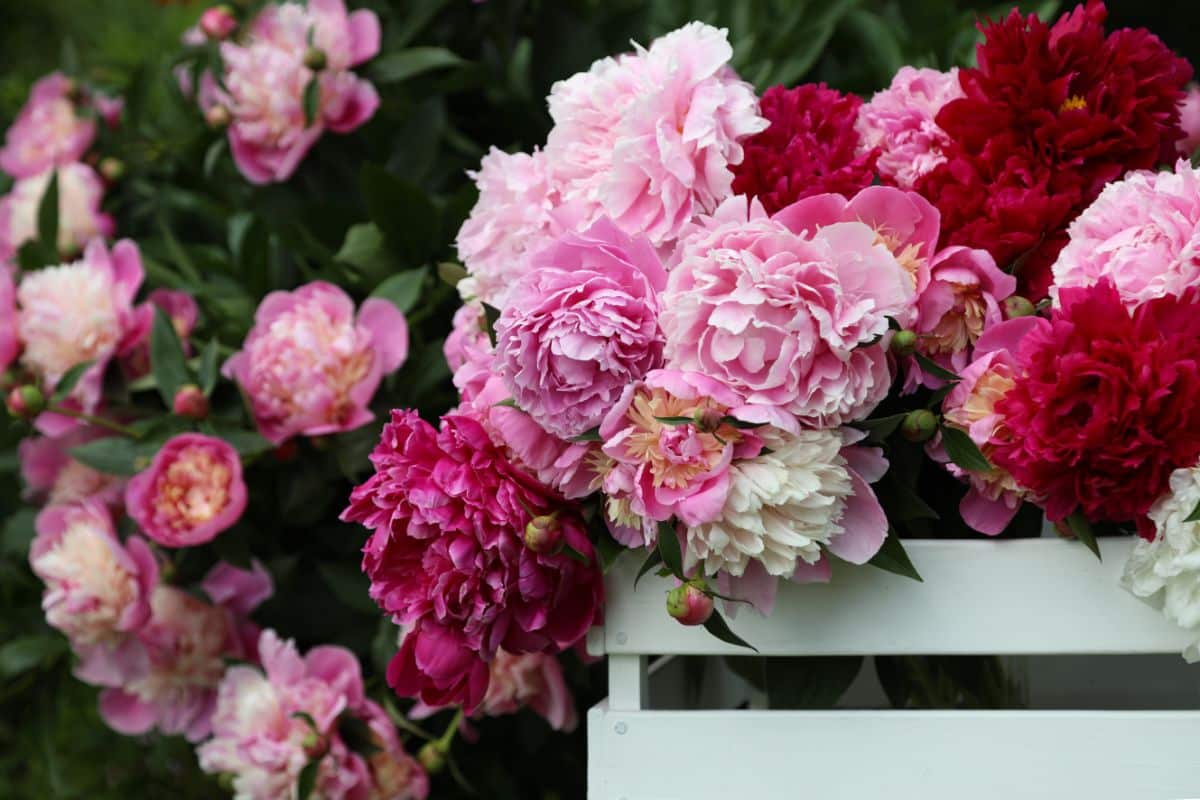
| Plant name: | Peonies |
| Light requirements: | Full sun |
| Water requirements: | Moderate |
| Grow zone: | Zones 3 to 8 |
| Toxic to pets: | Yes |
Pretty as a picture, peonies are prized for their oversized, globe-shaped flowers, which typically come in shades of pink and white, although you can find peonies in other colors as well. In cut flower arrangements, peonies look spectacular with irises, roses, and other big blooms; however, peonies are versatile enough to work with more subtle flowers, like baby’s breath. Peonies also exude a fine, floral fragrance that can uplift anyone’s spirits when they bloom in late spring to early summer.
Despite their impressive look, peonies are easy-going plants that can grow in most gardens as long as they receive plenty of bright sunlight. These plants are susceptible to mildew issues, though, so it’s important to only water peonies at the soil line and keep their leaves as dry as possible. Peonies may also benefit from staking since they can become quite top-heavy when in bloom.
14. Ageratum (Ageratum houstonianum)
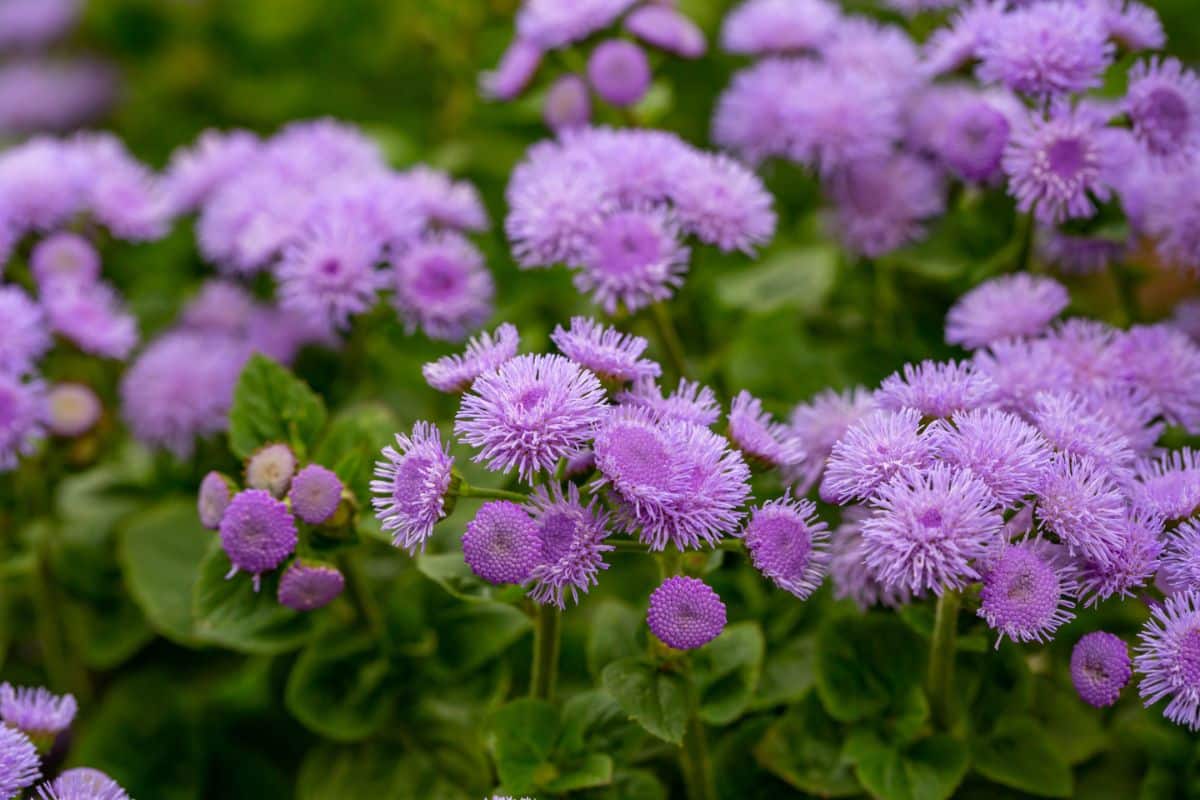
| Plant name: | Ageratum |
| Light requirements: | Full sun to part shade |
| Water requirements: | Moderate |
| Grow zone: | Zones 10 to 11, grown as annuals in most locations |
| Toxic to pets: | Yes |
Also known as flossflower and Mexican paintbrush, Ageratum is commonly used as filler flowers in arrangements, but their adorable, pompom-like flowers can make darling bouquets on their own. These fragrant flowers come in shades of pink, purple, and blue, and they are a charming complement to peonies, daisies, and yarrow.
Ageratums are annuals, and they will need to be planted every year if you want them to keep coming back. But, while you can grow these plants from seed, you can get flowers earlier in the season if you grow your plants from nursery starts. When mature, Ageratum is a reliable bloomer, and it can keep producing flowers from spring to fall.
15. Zinnias (Zinnias spp.)

| Plant name: | Zinnias |
| Light requirements: | Full sun; may benefit from part afternoon shade in hot areas |
| Water requirements: | High |
| Grow zone: | Zones 3 to 10 |
| Toxic to pets: | No |
Zinnias have a similar look and feel to dahlias, and they are just as brightly colored, but unlike dahlias, zinnias are usually grown as annuals from seed. These plants come in a range of sizes, from 6” tall dwarf varieties to large, 4’ tall flowers. Small zinnias are exceptional plants to grow in pots, but they can also be grown towards the front of flower beds, where their vibrant flowers will show to their fullest.
Taller zinnias are usually the best for cut flower arrangements as they have longer stems that will work with more varieties of vases. If you want to grow zinnias from seed, you can sow seeds indoors in mid-spring for earlier blooms or directly sow them outdoors after the danger of frost has passed. Zinnias are also often sold as nursery starts, and sowing pre-started plants will give you blooms earlier in the season.
16. Daffodils (Narcissus spp.)
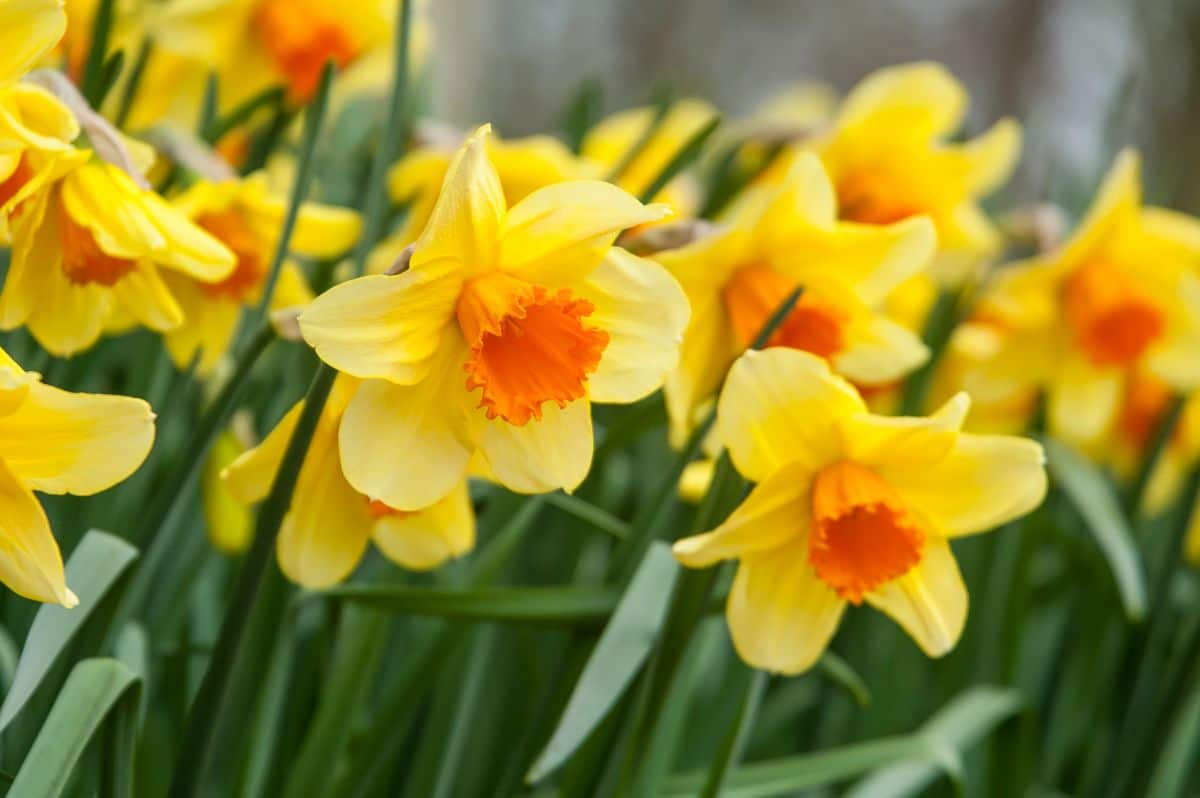
| Plant name: | Daffodils |
| Light requirements: | Full sun |
| Water requirements: | Moderate |
| Grow zone: | Zones 3 to 8 |
| Toxic to pets: | Yes |
Another spring bloomer, daffodils are some of the first flowers to appear in spring, and they’re a must-grow plant if you want to create springtime bouquets. Like tulips, daffodil bulbs are planted in autumn, and they will grow even better if you add a bit of compost to the planting hole at the time of sowing. These plants are also relatively resistant to most pests, and bulbs are unlikely to be targeted by squirrels and other burrowing rodents.
While yellow daffodils are classic, you find daffodils in white and other pastel shades. Some daffodils have two-toned flowers for even more color, and they work very well in arrangements with tulips, hyacinths, and other springtime favorites.
17. Alliums (Allium spp.)
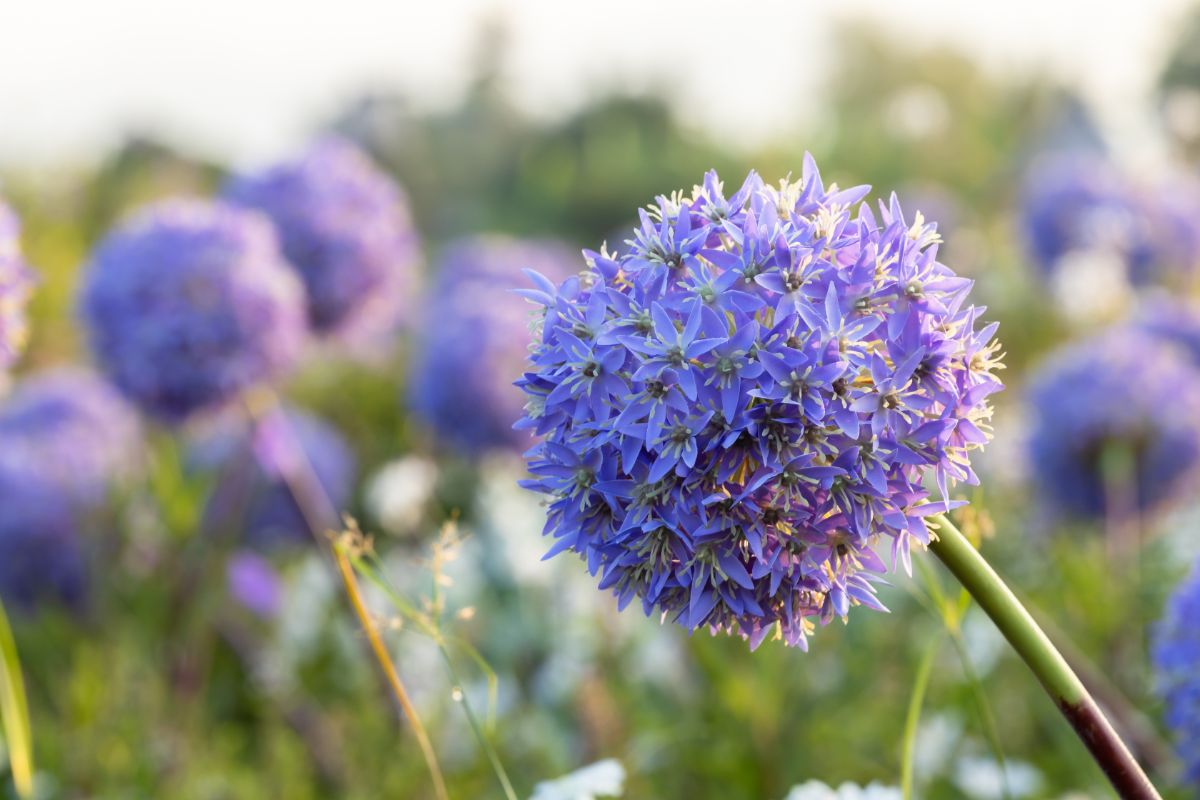
| Plant name: | Alliums |
| Light requirements: | Full sun to part shade |
| Water requirements: | Moderate to low |
| Grow zone: | Zones 3 to 8 |
| Toxic to pets: | Yes |
If you like more modern flower arrangements, alliums can be a fun plant to keep because they create such a striking silhouette. Alliums have large, globe-shaped flower heads that come in various shades of purple and white. In bouquets, they are hard to miss, and they can work well with a variety of flowers, but they look particularly alluring when paired with ornamental grasses, irises, or other plants with strong shapes.
Alliums are generally grown from bulbs that are planted in autumn; however, they bloom a bit later in the season than daffodils and tulips. Usually, alliums flower in late spring to early summer, and then the plant’s foliage dies back as the temperatures rise. As with daffodils, allium bulbs are generally pest resistant and not likely to be dug up by rodents.
18. Ranunculus (Ranunculus spp.)
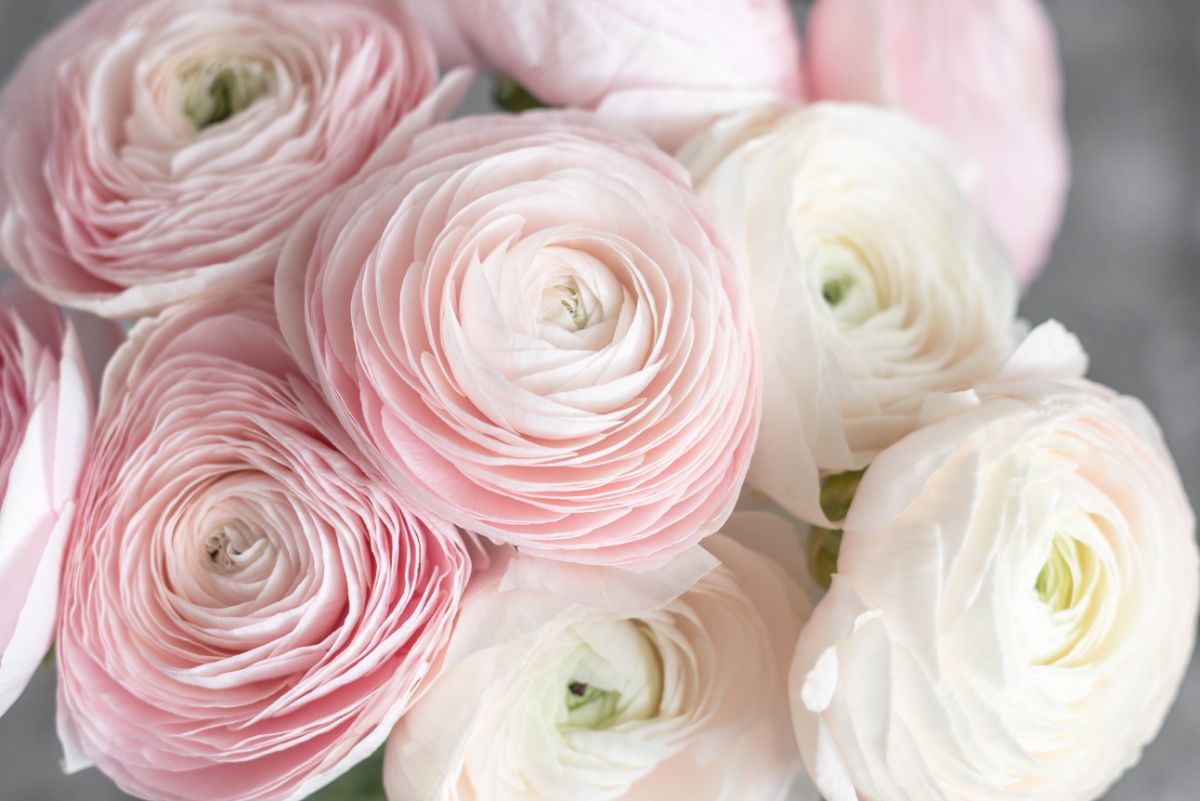
| Plant name: | Ranunculus |
| Light requirements: | Full sun; may benefit from part afternoon shade in hot areas |
| Water requirements: | Moderate |
| Grow zone: | Zones 8 to 10, corms can be overwintered indoors in cooler climates |
| Toxic to pets: | Yes |
With brilliant flowers that are packed with layers of paper-thin petals, ranunculus slightly resembles peonies, but their flowers are smaller and slightly flatter in form. Ranunculus are also easier to find in different colors, including pinks, oranges, white, reds, and yellows. And while these plants are usually grown from corms, you can also find pre-started plants at most nurseries in spring.
If you want to grow ranunculus from corms, plant corms in autumn if you live in a warm location. However, if you’re located in zone 7 or below, corms should be planted after your last hard frost date, as ranunculus plants are quite susceptible to the cold. After planting, ranunculus can be grown as annuals in cold locations, or you can dig up corms in autumn and overwinter them indoors.
Summary
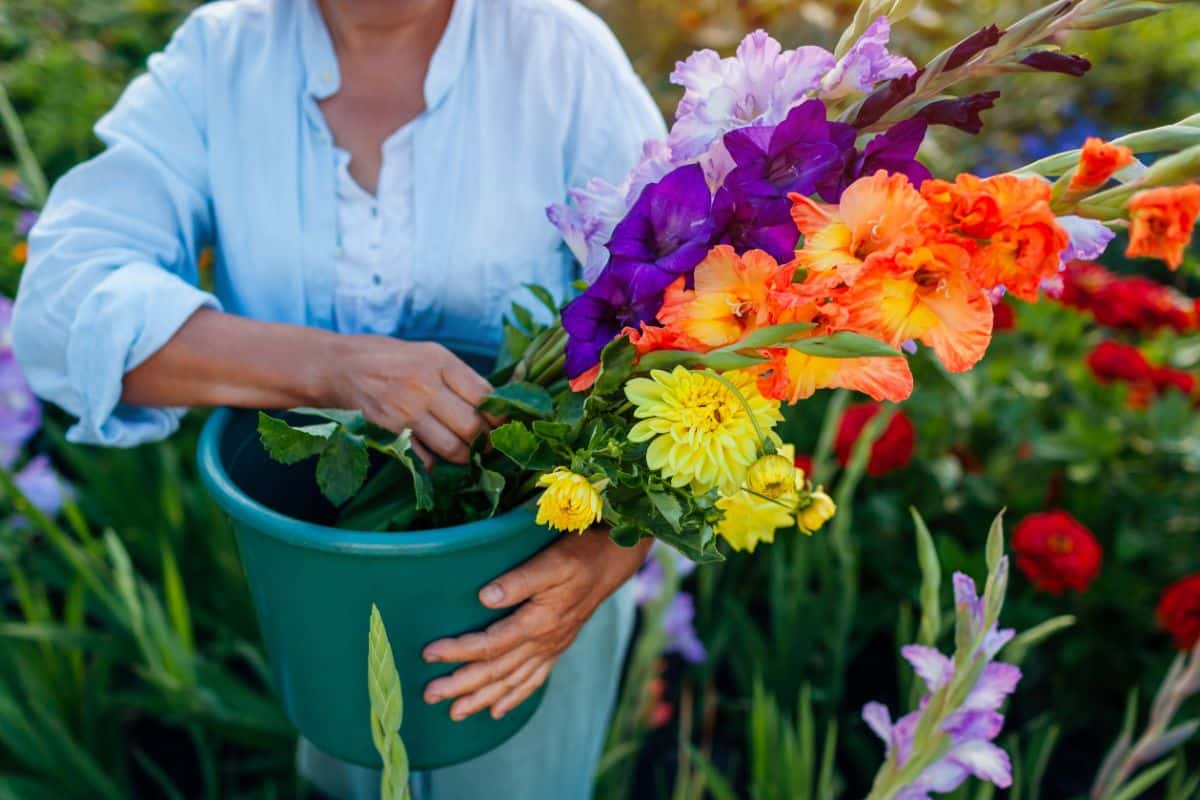
Growing your own cut flowers can save you a lot of money if you like making homemade flower arrangements, and cut flowers can also be lucrative plants to grow if you’re interested in market gardening. That said, all of the plants we’ve covered today look so enchanting in garden beds that you may not want to pick them at all, and that’s totally fine too!
We hope you’ve discovered some new flowers to grow in this guide, but if you’re still searching for the right plants for your garden, you may want to check out these top fragrance flowers for even more garden inspiration.

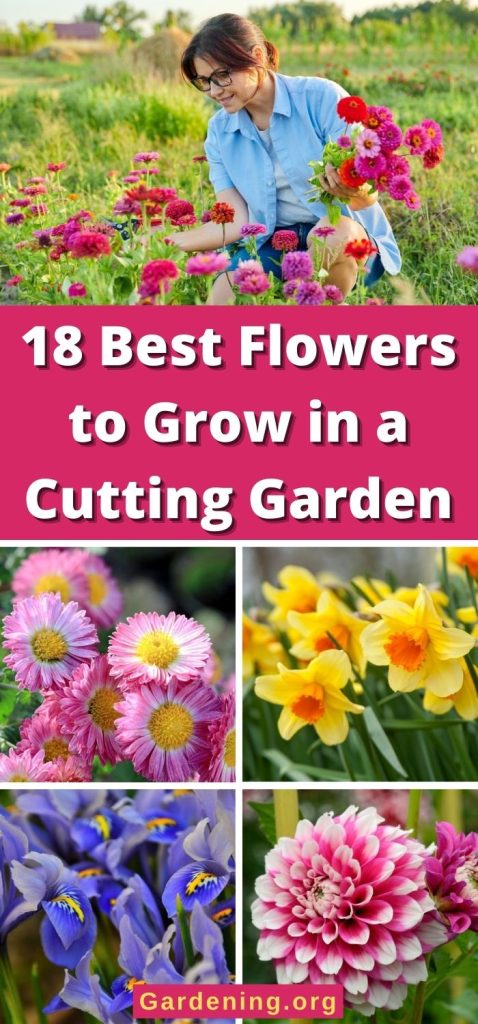

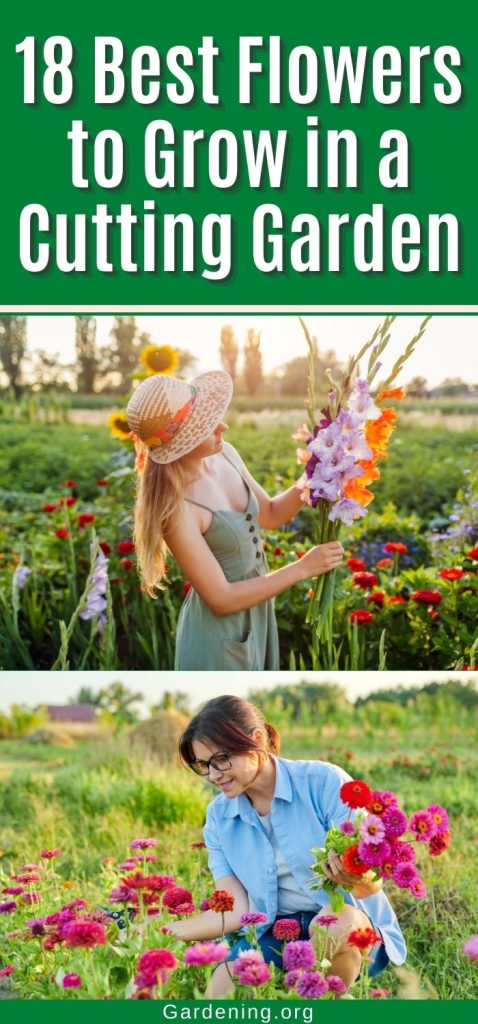
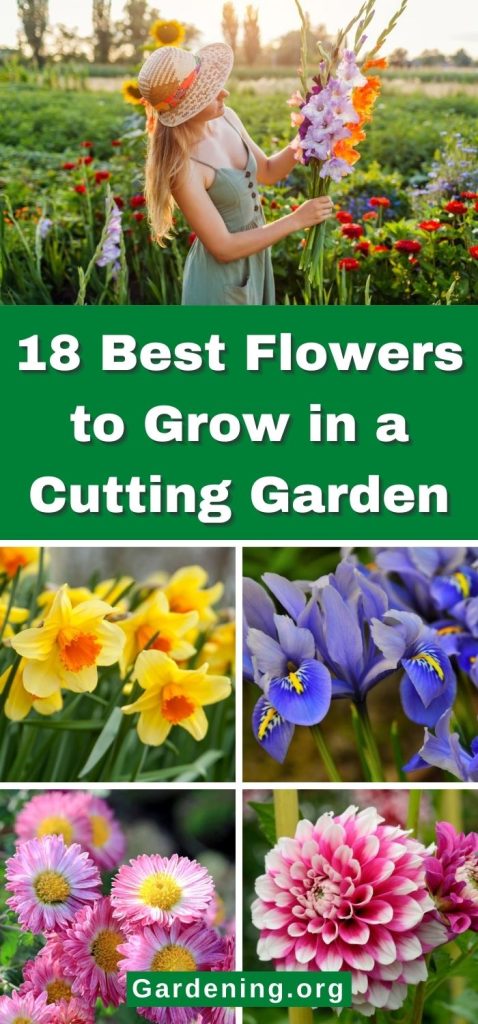

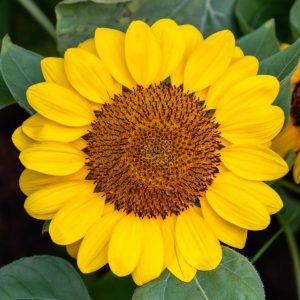
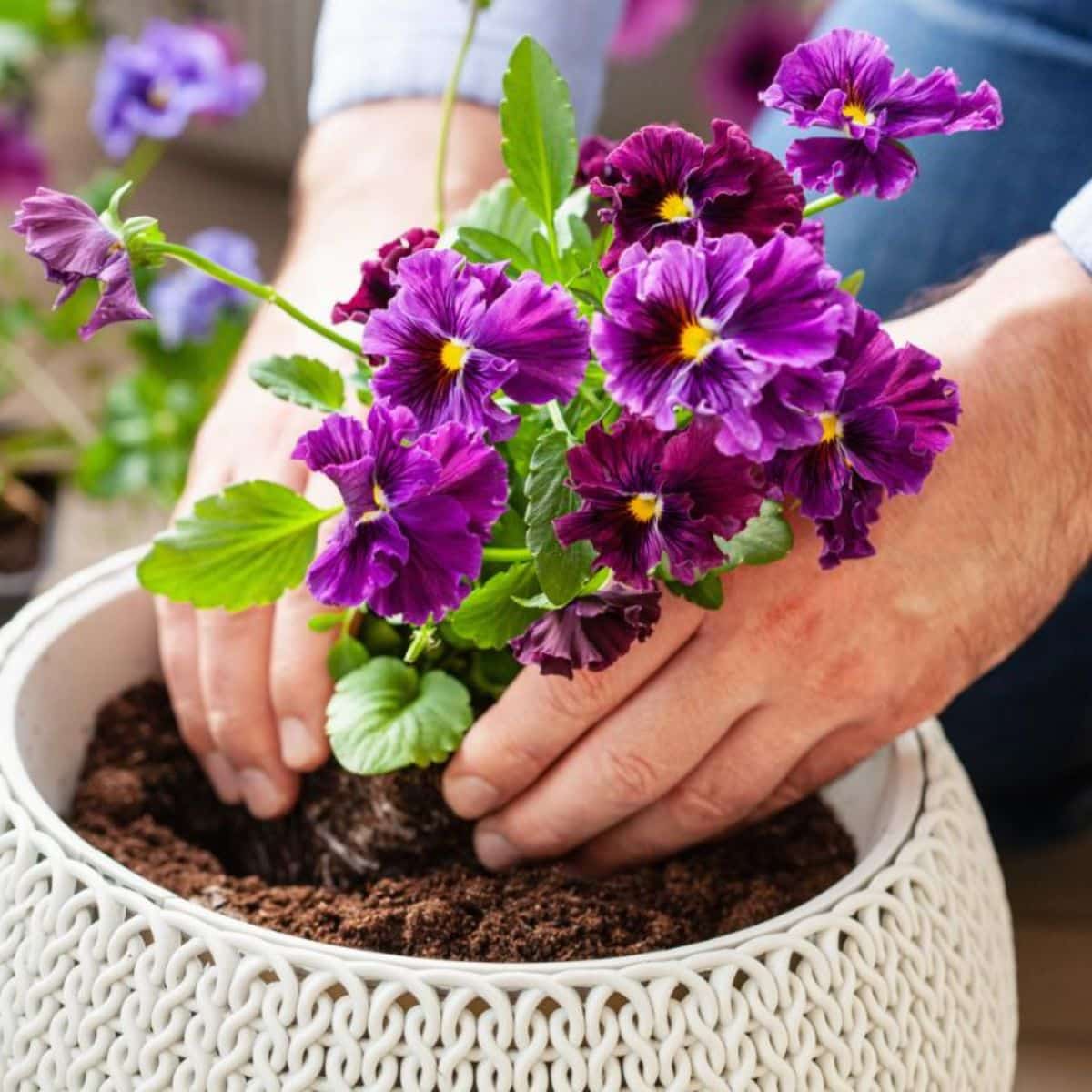
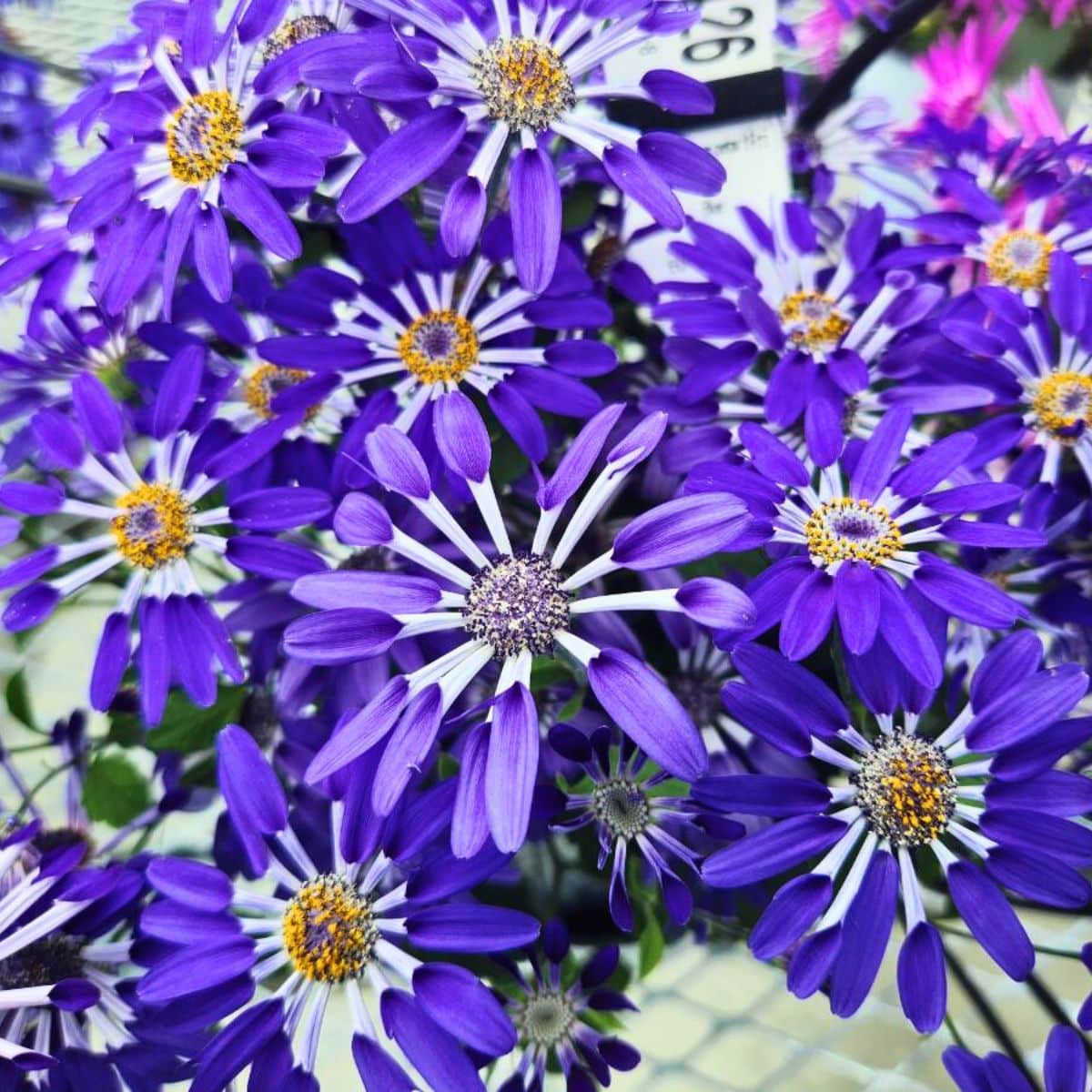
Leave a Reply